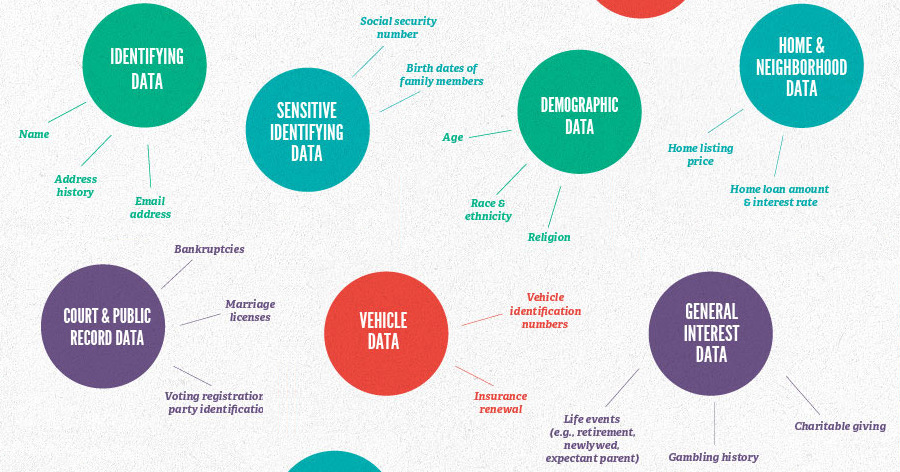Technology
How Much Is Your Personal Data Worth?
In a world where big data reigns supreme, sources of highly detailed and granular information can be very valuable to companies.
But what if that information is about you?
The Price of Personal Data
The following infographic from MBA@UNC looks at the business of data brokers, how they get their data, and what they sell it for.
It also puts a price tag on what users are willing to “pay” to not have their data collected.

It’s often said that if you are not paying for something, it should be known that you are the product.
In other words, companies may offer a free service to you in exchange for your personal information. Then, that data is used to sell targeted ads, or is re-sold for profit.
Buying and Selling Personal Data
Here are some examples of how companies may do this:
- Google and Facebook dominate the digital advertising market by using your data to allow marketers better targeting options. Did you know you can download a copy of your Facebook data, including every ad you ever clicked on?
- Loyalty cards also work because of personal data – they are free to the user, but help businesses collect data on you and your spending habits.
- Data from your mobile phones (such as geo-location) can be resold by your telecommunications company to other groups.
Once you hand your data over, it can be mined or re-sold, ending up in large databases of personal data.
Companies such as Axciom then curate data from multiple sources to come up with “more than 1,000 customer traits and basic information including location, age and household details”, as well as “more than 3,500 specific behavioral insights, such as propensity to make a purchase”.
Data brokers make money by selling this data compiled in comprehensive lists or databases to marketers, non-profits, and fundraisers. The data isn’t on you personally, but aggregated into some type of a typical buying profile such as “Affluent males interested in technology products”.
It then comes full circle, as your data is used by businesses or non-profits to target people just like you for future purchases.
Brands
How Tech Logos Have Evolved Over Time
From complete overhauls to more subtle tweaks, these tech logos have had quite a journey. Featuring: Google, Apple, and more.

How Tech Logos Have Evolved Over Time
This was originally posted on our Voronoi app. Download the app for free on iOS or Android and discover incredible data-driven charts from a variety of trusted sources.
One would be hard-pressed to find a company that has never changed its logo. Granted, some brands—like Rolex, IBM, and Coca-Cola—tend to just have more minimalistic updates. But other companies undergo an entire identity change, thus necessitating a full overhaul.
In this graphic, we visualized the evolution of prominent tech companies’ logos over time. All of these brands ranked highly in a Q1 2024 YouGov study of America’s most famous tech brands. The logo changes are sourced from 1000logos.net.
How Many Times Has Google Changed Its Logo?
Google and Facebook share a 98% fame rating according to YouGov. But while Facebook’s rise was captured in The Social Network (2010), Google’s history tends to be a little less lionized in popular culture.
For example, Google was initially called “Backrub” because it analyzed “back links” to understand how important a website was. Since its founding, Google has undergone eight logo changes, finally settling on its current one in 2015.
| Company | Number of Logo Changes |
|---|---|
| 8 | |
| HP | 8 |
| Amazon | 6 |
| Microsoft | 6 |
| Samsung | 6 |
| Apple | 5* |
Note: *Includes color changes. Source: 1000Logos.net
Another fun origin story is Microsoft, which started off as Traf-O-Data, a traffic counter reading company that generated reports for traffic engineers. By 1975, the company was renamed. But it wasn’t until 2012 that Microsoft put the iconic Windows logo—still the most popular desktop operating system—alongside its name.
And then there’s Samsung, which started as a grocery trading store in 1938. Its pivot to electronics started in the 1970s with black and white television sets. For 55 years, the company kept some form of stars from its first logo, until 1993, when the iconic encircled blue Samsung logo debuted.
Finally, Apple’s first logo in 1976 featured Isaac Newton reading under a tree—moments before an apple fell on his head. Two years later, the iconic bitten apple logo would be designed at Steve Jobs’ behest, and it would take another two decades for it to go monochrome.
-

 Maps1 week ago
Maps1 week agoThe Largest Earthquakes in the New York Area (1970-2024)
-

 Money2 weeks ago
Money2 weeks agoWhere Does One U.S. Tax Dollar Go?
-

 Automotive2 weeks ago
Automotive2 weeks agoAlmost Every EV Stock is Down After Q1 2024
-

 AI2 weeks ago
AI2 weeks agoThe Stock Performance of U.S. Chipmakers So Far in 2024
-

 Markets2 weeks ago
Markets2 weeks agoCharted: Big Four Market Share by S&P 500 Audits
-

 Real Estate2 weeks ago
Real Estate2 weeks agoRanked: The Most Valuable Housing Markets in America
-

 Money2 weeks ago
Money2 weeks agoWhich States Have the Highest Minimum Wage in America?
-

 AI2 weeks ago
AI2 weeks agoRanked: Semiconductor Companies by Industry Revenue Share















